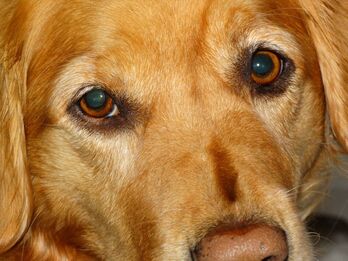Laurie Anne Walden, DVM Public domain photo from pixy.org Public domain photo from pixy.org Corneal ulcers are common causes of eye redness in dogs and cats. A corneal ulcer is an area of damage to the surface of the cornea, the clear structure at the front of the eye. These ulcers are painful but usually heal readily with treatment. Sometimes corneal ulcers develop complications that require surgery or other interventions. Causes Anything that scratches, hits, or irritates the surface of the eye can cause a corneal ulcer. Animals with low tear production are at increased risk for corneal ulcers because they have a low volume of tears to wash away irritants. These are some of the things that cause corneal ulcers:
Complications Some animals have a defect of the corneal epithelium—the surface layer of corneal cells—that increases the risk of ulcers and keeps ulcers from healing. These slow-healing ulcers are called indolent ulcers. Corneal ulcers can become infected, threatening the animal’s vision. Deep corneal ulcers and wounds can penetrate all the way through the cornea and rupture the eye. Eye medications that contain steroids (commonly used to treat conjunctivitis and other inflammatory eye conditions) prevent corneal ulcers from healing properly. Steroid-containing eye medications can also increase the risk of corneal infection. Signs The signs of eye discomfort are the same whether they are caused by a corneal ulcer or by another eye disorder. Typical signs are squinting, redness of the white part of the eye, and clear or cloudy eye drainage. The animal might rub the eye, and the cornea might look cloudy. Deep ulcers are sometimes visible without an ophthalmoscope and look like a dent or divot in the cornea. Superficial ulcers are usually not visible to the naked eye. An animal with any of these signs should see a veterinarian right away. Although uncomplicated corneal ulcers are relatively minor, they are painful. Some of the conditions that cause the same signs are medical emergencies that require immediate treatment to save the eye. Diagnosis Corneal ulcers are diagnosed with fluorescein dye applied to the eye. This green dye shows areas where the normal corneal epithelium is disrupted or missing. The eye is also examined under magnification to assess the depth and size of the ulcer, detect complications, and find the cause. Treatment An uncomplicated ulcer is treated with eye medication to prevent infection and relieve pain. The animal might be fitted with a protective collar (the lampshade type) to prevent eye rubbing. The cause of the ulcer is also treated, if possible. The eye is rechecked with fluorescein dye after a few days to be sure the ulcer has fully healed. Complicated ulcers are treated according to their cause and severity. Indolent ulcers are treated with a procedure to remove loose corneal epithelium. This procedure can often be performed in an awake animal with drops to numb the eye. Some indolent ulcers need a more extensive procedure with the animal under general anesthesia. Deep ulcers and wounds that might rupture the eye need surgical treatment by a veterinary ophthalmologist. Image source: https://pixy.org/6427021/ Comments are closed.
|
AuthorLaurie Anne Walden, DVM Categories
All
Archives
June 2024
The contents of this blog are for information only and should not substitute for advice from a veterinarian who has examined the animal. All blog content is copyrighted by Mallard Creek Animal Hospital and may not be copied, reproduced, transmitted, or distributed without permission.
|
- Home
- About
- Our Services
- Our Team
-
Client Education Center
- AKC: Spaying and Neutering your Puppy
- Animal Poison Control
- ASPCA Poisonous Plants
- AVMA: Spaying and Neutering your pet
- Biting Puppies
- Boarding Your Dog
- Caring for the Senior Cat
- Cats and Claws
- FDA warning - Bone treats
- Force Free Alliance of Charlotte Trainers
- Getting your Cat to the Vet - AAFP
- Holiday Hazards
- How To Feed Cats for Good Health
- How to Get the Most Out of your Annual Exam
- Indoor Cat Initiative - OSU
- Introducing Your Dog to Your Baby
- Moving Your Cat to a New Home
- Muzzle Training
- Osteoarthritis Checklist for Cats
- What To Do When You Find a Stray
- Our Online Store
- Dr. Walden's Blog
- Client Center
- Contact
- Cat Enrichment Month 2024
|
Office Hours
Monday through Friday 7:30 am to 6:00 pm
|
Mallard Creek Animal Hospital
2110 Ben Craig Dr. Suite 100
|
Site powered by Weebly. Managed by IDEXX Laboratories

 RSS Feed
RSS Feed